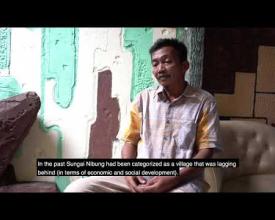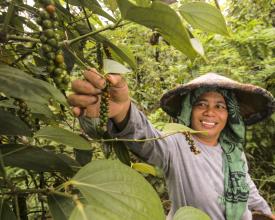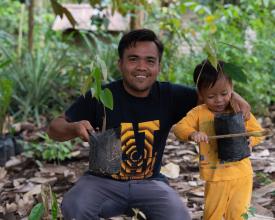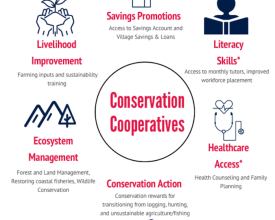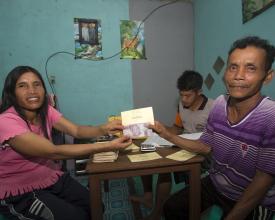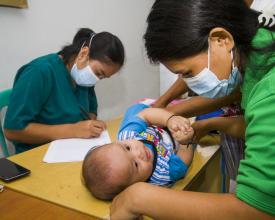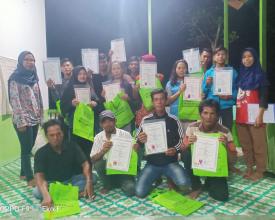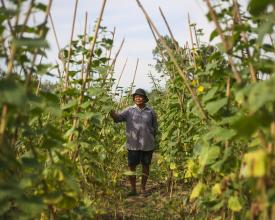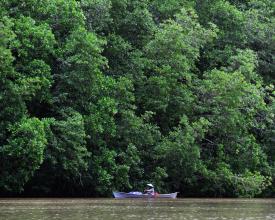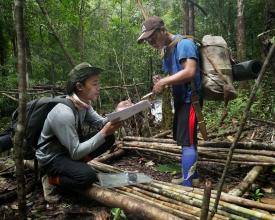Catalyzing Community-led Conservation to Reduce Deforestation and Biodiversity Loss through an Integrated Ecosystem Approach – West Kalimantan, Indonesia
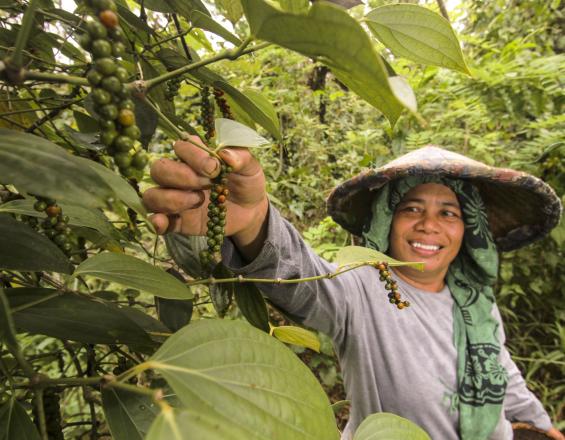
At Yayasan Planet Indonesia we are dedicated to conserving Earth's at-risk ecosystems. In Indonesia, we have pioneered a model of community-based conservation through our ‘Conservation Cooperative’ model that addresses the underlying drivers causing climate change vulnerability in our partner communities. We create village-led partnerships to support ecosystem-based adaptation (EbA) by instituting community governance structures (Conservation Cooperatives) that enable access to financial and non-financial services that catalyze community-based adaptation. Using our award-winning approach, we establish ‘Conservation Cooperatives’ (CC) to develop pathways for vulnerable rural communities to overcome the barriers to climate change adaptation. Simultaneously our CC approach builds EbA by securing the well-being benefits (e.g. livelihood, health) that humans derive from ecosystem services (e.g. forests, land, fisheries, etc.), and facilitates how these benefits can be utilized to promote climate change adaptation.
Context
Challenges addressed
Rural communities living in tandem with West Kalimantan ecosystems often suffer from socio-economic insecurities due to unmet social and financial needs (Social and Economic Challenge). These barriers drive them to exploit surrounding natural resources beyond their subsistence needs, reducing the resilience of the very ecosystems (Environmental Challenge) that act as their lifeline. As a result, the goods and services these ecosystems provide to the rural communities are at risk of collapsing, thereby removing the lifeline that underpins local livelihoods and well-being. As rural communities deplete their surrounding natural resources, it creates a positive feedback loop deepening their inability to meet basic and financial needs leading to further resource extraction culminating in spiraling poverty. Such degenerative exploitation of natural resources traps communities into a vicious cycle of environmental injustice and reduces the integrity of surrounding natural ecosystems that they depend on
Location
Process
Summary of the process
Before establishing village-level partnerships through which we develop these ‘building blocks’, we engage in radical listening through community hearings and focus group discussions. These hearings and discussions enable us to understand specific community needs, challenges, and what communities think are solutions to their challenges. We use this information to build and match our activities to fit the needs and solutions put forth by local communities. Thus we have moved away from a ‘community-based’ approach to a ‘community-led’ approach, highlighting our emphasis on ownership of initiatives at the local level.
Once communities agree to participate in program activities, we create a village level ‘conservation agreement’ that highlights the key aspects of our partnership with the village. As member’s join their cooperative they receive access to a variety of services provided under each building block that addresses a different aspect of community members' needs.
While each building block does not directly interact or depend on each other, all of them together are aimed at addressing the underlying factors that cause the vulnerabilities faced by community members in our partner villages.
Building Blocks
Village Savings and Loans Program
As part of every CC, we help initiate and support a community-led savings and loans (VSL) program through initial start-up capital and financial literacy training to CC members. The purpose of our Village Savings and Loan (VSL) Program is to develop a community-led savings program that enables access to low-burden loans for CC members and addresses the barrier for lack of access to equitable financial capital for community members to rely on to meet their financial capital needs. As a result, this program enables access to an equitable source of capital for CC members that they can use to develop and diversify their livelihoods and improve their family’s wellbeing.
Once the VSL fund is operational, CC members can apply for a loan by submitting a proposal describing how they will use the funds and when they will return the capital along with other information. Based on the proposal and its merit, the CC committee on loans holds the authority to approve the loan to the requesting member. As loans are repaid, a small amount of a member’s profit (1-5%) is accrued in the community managed VSL program allowing it to grow and be sustainable in the long-run.
Enabling factors
As the cornerstone of every CC and our commitment to community members, we provide a small seed money for each new CCs to establish their VSL program in exchange for their pledge to ensure the management and development of the fund. Another key enabling factor is that borrowers use the loans or a part thereof in productive purposes that provides the opportunity to improve livelihoods
Lesson learned
We have learned that reducing the short-term opportunity costs of conservation is extremely important to sparking interest in long-term management. VSLs can help facilitate this by (i) providing direct access to short-term incentives, (ii) providing financial security in times of need, and (iii) enhancing collaboration at the community level. Since VSLs depend on group savings and group loans, this financial mechanism can serve as a platform to discuss wider issues, such as conservation area management. Monthly meetings with VSL groups offer important opportunities to discuss issues, enhance collaboration, and build participatory platforms for collective action. As effective community-led conservation often revolves around a common pool resource, these regular gatherings, incentivized through the VSL, are critical for equitable local management.
Resources
Healthy Family Program
We train local women and girls to become health ambassadors (HA) in their communities and act as extension agents for public health services. As part of this program, we work with local government health offices to improve access to health services, community health, and improve women’s reproductive rights through the extension of government health services in partner villages. We follow the People- Health -Environment (PHE) approach that aims to improve community health through health advocacy and improve access to basic services. Once potential HAs are identified, they are provided with a set of training from our staff and 3 additional training from the relevant government agency. Once they have successfully completed these trainings, HAs start to make weekly visits to households in their communities. During these visits, they evaluate each household’s activities and provide information on pre-and post-natal health, contraceptives, sanitation issues, impacts of smoking, and nutrition. Information is provided through posters and videos played on smartphones carried by health ambassadors
Enabling factors
The enabling factors for implementing this program is lack of access to such services in the community and a link between human health and ecosystem health. Community hearings or workshops are required to kick-start this intervention as often communities lack awareness of public health measures and fail to identify poor health as a barrier to community engagement and well-being. We have found this to often be the case where communities tend to focus on monetary measures of rural poverty, rather than identifying education, health, and other well-being indicators.
Lesson learned
Several important lessons have been learned. First, community health initiatives, when implemented correctly with high-quality service delivery, can be essential to opening the door to wider community engagement. It is difficult to engage in natural resource management when one is often sick or has sick family members. Therefore, improving household health can open the door for wider engagement in community-level programming. Second, community health interventions are integral to building positive relationships and trust between NGOs and local communities. This can help create stronger partnerships, facilitate collaboration, and create space for more difficult conversations around social-ecological interactions
Resources
Literacy Program
Our Literacy Program creates access to basic education for our partner communities, especially rural women and youth, who lack the ability to complete their education. Our evaluative admissions method ensures students graduate through our literacy program in the shortest possible time in order to capitalize on opportunities for employment and further studies. We take the support of organizations who are experts in the education sector in Indonesia such as Pusat Kegiatan Belajar Masyarakat (PKBM). PKBM is a registered Indonesian NGO that provides literacy training and administers government national exams. Students who pass the national exam receive a certificate that helps with job placement and improves access to the labor force.
As part of this program, we also support the training of local tutors in partnership with local government schools and PKBM. By training local people to become tutors in their communities, we reduce the costs for community members to gain access to basic education in hard-to-reach communities.
Enabling factors
Key enabling factors for this program include the willingness of local students who lack access to such services to participate in the program. This building block also is enabled by participatory design (e.g. both problem and solution) and mapping. Through this exercise facilitators can work with community members to draw links between various social barriers and overall social-ecological outcomes.
Lesson learned
Similar to other social-economic services described in our approach, education services serve as an important entry point and building block for creating positive and healthy relationships with communities. We have also learned education and health services seem to be particularly important at incentivizing for the participation of women in the overall community-led scheme. This is essential as community-led conservation cannot be properly achieved without gender mainstreaming.
Resources
Sustainable Agriculture and Agroforestry Program
The purpose of our Sustainable Agriculture and Agroforestry program is to enhance soil nutrition and fertility while also regenerating degraded forest lands and ensuring food security. As part of this program, we develop groups of 15-20 farmers from a CC who are then mentored by a peer-selected lead farmer trained by us. This enables us to readily share information about improved techniques and maximize knowledge sharing and learning among the farming communities. Furthermore, since 2017, we have supported communities to select and plant over 60,000 seedlings of native species in the buffer zones in our terrestrial sites and replant abandoned aquaculture pond with 38,000 mangrove seedlings in our coastal sites. This not only ensures food, nutrition and livelihood for participating smallholder farming communities but also creates crucial habitat and connectivity for wildlife, and generates regulating and provisioning services.
Enabling factors
The key enabling factor to enable success of our sustainable agriculture program is the ability to demonstrate production benefits both in terms of higher yields and reduced cost for farmers. Other conditions that position this intervention as a building block in our overall program model is the relation between agriculture production and deforestation. This factor enables the intervention to be well positioned to achieve cross-sectoral outcomes of improved food security, reduced deforestation, and improved economic security.
Lesson learned
We have learned that a graduation style of an approach is extremely important. Often asking farmers to make too large of leaps in changing their behavior can be overwhelming, discouraging, and deter local action. A graduation approach makes changing behavior “gradual” and rewards farmers for small steps that are used to reach an overall goal. Therefore, as farmers move from step one to step two, they are adopting small changes (e.g. intercropping, semi-organic vs chemical), until they reach step four, which is a farmer who graduates from the program. This has been an important lesson learned for our organization.
Sustainable Fisheries Program
A key component of our sustainable fisheries program in our coastal site is the ‘participatory fisheries management’ intervention through which we co-implement periodic river closures. We designed this intervention in light of communities’ worry of collapse in fish, crab, and shrimp populations that had directly led to reduced household income. As this decline in fish stocks stemmed from lack of clear fishing grounds, inter-and intra-village conflict, and high rates of migrant fishermen from other areas entering the fishing grounds, we proposed the idea of a 3-month long river closure. Mud crabs were chosen as the species that would be targeted as part of the river closures particularly because they were among the most valuable commodities to small-scale fishermen and also a fast-growing species.
Before a river is closed to fishing, community fishermen use a map of their village's rivers to choose the location of the river that will be closed and decide the timing of the closure. The only thing they do not choose is the length of the closure, which has been chosen for 3-months in consultation with mud-crab experts. Once the rivers are opened to fishing, the small-scale fishermen are able to reap the benefits through the increased size of crabs and higher yields.
Enabling factors
An enabling factor for this activity is the monitoring of rivers during closures to deter and prohibit people from fishing. Another factor that can increase the success of the closures is to choose a location that is a known hotspot for mudcrabs (or the species targeted by the closure).
Lesson learned
Periodic closures offer an “easy to understand” and “easy to implement” management technique for coastal communities that can deliver quick returns. Also, we found that social and economic interventions at the village level are essential to incentivizing the participation of fisher communities in such management techniques. In case of unintended benefits, mud-crab fishermen explained that it helped them to “secure” their fishing grounds from migrant fishermen who come from other villages to catch fish in rivers surrounding their villages. Another benefit cited by fishermen were related to their time management. During Periodic Closures, fishermen were able to focus their time on daily activities away from mud crab fishing and concentrate on developing other sources of income for their families. Whereas previously they would go out to catch mud crabs every day which was actually a gamble for them, as they were not sure if they would catch enough crabs to at least pay for costs related to fuel for their boats.
SMART Patrol Program
In both our terrestrial and coastal sites we initiate community-led SMART patrol units that enable communities and government agencies to protect ecosystems in tandem. In our terrestrial sites, we identify, train, and equip local community members in using the Spatial Monitoring and Reporting Tool (SMART) to protect their forests in tandem with government park rangers. Teams are made up of 3 to 4 community members, 1 government staff, and 1 of our program team members. These teams carry out 7-10 days per month along paths generated by the SMART software based on historical data. Along with creating opportunities to track data on wildlife encounters, the SMART tool also allows tracking incidents of poaching and other illegal activity inside the protected forests. In our coastal site in Kubu Raya, SMART patrols are carried out by boats 3 days a week (12 days a month). These dates are chosen randomly to create uncertainty in the patrol schedules.
Enabling factors
Community-led SMART patrols work best in areas where communities have rights over, or co-management, of a conservation area. For our work in West Kalimantan we have applied SMART patrols both to community conservation areas (forests and fisheries), as well as co-management of protected areas between government management authorities and local communities.
Lesson learned
Several important lessons have been learned. First, the entry points to SMART patrols are extremely important. For most communities in the global south it is likely that this is a sensitive topic, and community members may feel that their livelihoods are threatened by the creation of a patrol team. We have learned that a viable entry point is phrasing SMART patrols a management and protection tool that helps communities to (i) keep outsiders who may be stealing their resources out, and (ii) enforce community participatory management agreements. Second, SMART patrols do require a learning curve and we highly recommend that NGOs ensure that each patrol team has one fully-trained and well-versed staff member accompanying patrols for the first year (or longer). Third, when implementing this in protected areas, it is essential to bring government park rangers and community members together over patrolling. This further supports a strong partnership between the two entities that is essential for long-term management of a protected or conservation area.
Impacts
- Environmental
Deforestation rates dropped by 56% surrounding our partner villages in comparison to 2 years prior to our program implementation in the Gunung Niut Nature Reserve, with 77% of the tree cover loss taking place outside of our partnership areas. In our coastal site, mangrove forests were lost at a rate of 56.7 ha/year before the start of the project (2014 to 2017), which reduced to 23 ha/year three years after project implementation began (2018 to 2020).
- Social
Our Healthy Family Initiative and Literacy Programs directly address gaps in social services in our partner communities. Till date, we have trained 157 local women as health ambassadors in their communities who conduct household visits and create access to public health information and services for women and girls in their communities. Since 2017, out of a total of 559 participants in our literacy program, 264 participants have completed the course of which 251 have passed the National Exam (a 95% pass rate) and received a nationally recognized certificate that will enable them to seek formal employment opportunities.
- Economic
As of June 2021, there was a total of USD$ 99,762 in assets in our Village Savings and Loans program across 21 Conservation Cooperatives in all 3 of our project sites. A total of USD$ 45,859 had been taken out in loans by CC members during the project period with a >90% loan repayment rate.
Beneficiaries
Our beneficiaires include Dayak communities inhabiting Gunung Niut and Gunung Naning sites, and coastal non-Dayak fishing communities inhabiting our project sites in Kubu Raya Mangrove Forests
Sustainable Development Goals
Story
Pak Jaka has been a fisherman for over 20 years but this is his first time fishing for crabs in Sungai Nibung after the most recent 3-month river closure. In the region of Kubu Raya, the villagers with the support of Yayasan Planet Indonesia have set up a temporary closure system to mitigate fish stock depletion as part of a wider conservation mission.
These temporary closures work by periodically banning fishing and usage of an area during set months to allow the population to restore itself and mature. This is to ensure natural resources can be relied upon for generations to come while also engaging communities in conservation.
The day the rivers opened for fishing again, Pak Jaka rose with the sun to set out 50 crab traps in the river of Nibung. As he pulls his first cage out of the water, it’s a miss. The second cage, however, hauls a nice big crab out of the water and he’s face breaks out into a smile. Prior to Planet Indonesia’s partnership with the village, unrestricted fishing had crushed crab and shrimp populations, getting smaller with each harvest. Pak Jaka says the crabs and income are noticeably better in the regions that practice these temporary fishing closures. This is the third periodic closure implemented in the village of Sungai Nibung.
